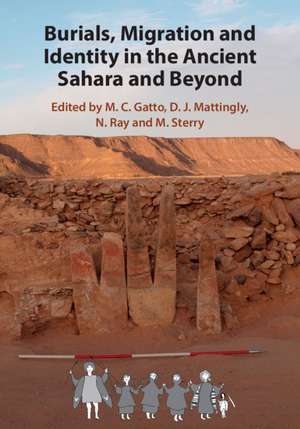Burials, Migration and Identity in the Ancient Sahara and Beyond: Trans-Saharan Archaeology
Editat de M. C. Gatto, D. J. Mattingly, N. Ray, M. Sterryen Limba Engleză Hardback – 13 feb 2019
Preț: 693.11 lei
Preț vechi: 961.16 lei
-28% Nou
Puncte Express: 1040
Preț estimativ în valută:
132.64€ • 144.03$ • 111.42£
132.64€ • 144.03$ • 111.42£
Carte indisponibilă temporar
Doresc să fiu notificat când acest titlu va fi disponibil:
Se trimite...
Preluare comenzi: 021 569.72.76
Specificații
ISBN-13: 9781108474085
ISBN-10: 110847408X
Pagini: 586
Ilustrații: 130 b/w illus. 19 maps 22 tables
Dimensiuni: 184 x 256 x 27 mm
Greutate: 1.32 kg
Editura: Cambridge University Press
Colecția Cambridge University Press
Seria Trans-Saharan Archaeology
Locul publicării:Cambridge, United Kingdom
ISBN-10: 110847408X
Pagini: 586
Ilustrații: 130 b/w illus. 19 maps 22 tables
Dimensiuni: 184 x 256 x 27 mm
Greutate: 1.32 kg
Editura: Cambridge University Press
Colecția Cambridge University Press
Seria Trans-Saharan Archaeology
Locul publicării:Cambridge, United Kingdom
Cuprins
Preface David J. Mattingly; 1. Burials, migration and identity: the view from the Sahara David J. Mattingly, Maria Carmela Gatto, Martin Sterry and Nick Ray; Part I. Burial Practices in the Central Sahara: 2. Dying to be Garamantian: burial, migration and identity in Fazzan David J. Mattingly, Martin Sterry and Nicholas Ray; 3. Identity markers in the South-Western Fazzan: were the people of the Tanezuft/Tadrart Akakus region Garamantes? Maria Carmela Gatto, Lucia Mori and Andrea Zerboni; 4. Human mobility and identity: variation, diet and migration in relation to the Garamantes of Fazzan Ronika K. Power, Efthymia Nikita, David J. Mattingly, Marta Mirazón Lahr and Tamsin C. O'Connell; 5. The Garamantes from Fewet (Ghat, Fazzan, Libya): a skeletal perspective Francesca Ricci, Mary Anne Tafuri, Francesca Castorina, Fabio Di Vincenzo, Lucia Mori and Giorgio Manzi; Part II. Looking East: 6. Between the Nile and the Sahara: some comparative perspectives David N. Edwards; 7. Isotopic approaches to mobility in Northern Africa: a bioarchaeological examination of Egyptian/Nubian interaction in the Nile Valley Michele R. Buzon, Sarah A. Schrader and Gabriel J. Bowen; Part III. Looking North: 8. Numidian burial practices Joan Sanmartí, Irene Cruz Folch, Jordi Campillo and David Montanero; 9. Revisiting first Millennium BC graves in North-West Morocco Emanuele Papi; Part IV. Looking West: 10. Protohistoric and pre-Islamic funerary archaeology in the Moroccan pre-Sahara Youssef Bokbot; 11. Burial practices in Western Sahara Joanne Clarke and Nick Brooks; Part V. Looking South: 12. Burial and society at Kissi, Burkina Faso Sonja Magnavita; 13. Burial practices, settlement and regional connections around the Southern Lake Chad Basin, 1500 BC–AD 1500 Scott MacEachern; Part VI. Linguistic Aspects of Migration and Identity: 14. The linguistic prehistory of the Sahara Roger Blench; 15. Berber peoples in the Sahara and North Africa: linguistic historical proposals Christopher Ehret; 16. The archaeological and genetic correlates of Amazight linguistics Elizabeth Fentress; 17. Concluding discussion Martin Sterry, David J. Mattingly, Maria Carmela Gatto and Nick Ray.
Recenzii
'In Burials, Migration, and Identity in the Ancient Sahara and Beyond, Gatto, Mattingly, Ray, and Sterry bring together diverse datasets from all corners of the desert using an explicitly trans-Saharan approach. Inspired by developments in Mediterranean archaeology, they reframe the desert as a great interconnected sea that can only be understood in relation to its 'shorelands' on its eastern, northern, and southern peripheries. Instead of standing outside the desert looking in, as scholars and historians have done for centuries, this book is set within the Sahara looking out. Through this approach, the editors seek to understand how events and processes within this network shaped human lives across space and time.' E. A. Sawchuk, African Archaeological Review
Descriere
Places burial traditions at the centre of Saharan migrations and identity debate, with new technical data and methodological analysis.



